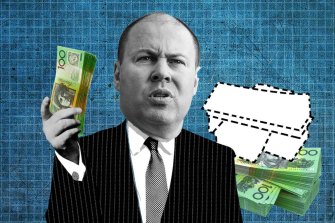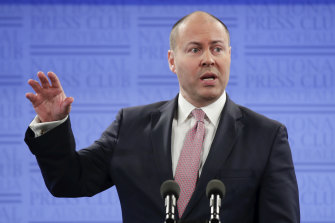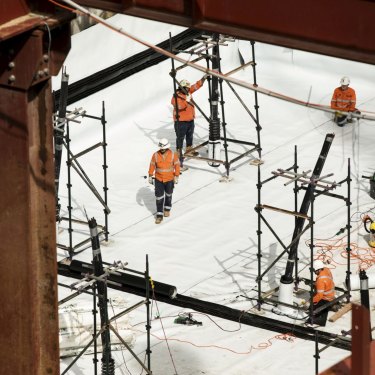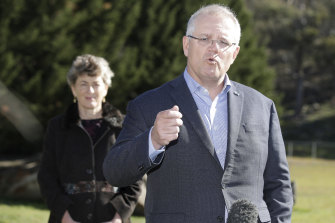How did Treasury get its cost estimate for the JobKeeper payment so wrong? Who, if anyone, is responsible? And what should be done now with the money?
It will go down as the biggest budget underspend in Australian history so far. From an initial $130-billion cost estimate, the government’s JobKeeper program now looks set to cost taxpayers just $70 billion – still ranking it among the biggest government programs ever.
But, instead of 6 million workers receiving the $1500 per fortnight payment through their employer, Treasury now estimates 3.5 million employees will get it.
So, how did they get it so wrong? Who, if anyone, is responsible? And what should be done now with the money?

Credit:Illustration Dionne Gain, Michael Howard
What is JobKeeper?
The government’s JobKeeper program was announced on March 30, the third instalment of the government's coronavirus economic support measures.
Ahead of every major policy announcement, it is the job of the Department of Treasury to provide an estimate of the anticipated cost of the program.
On March 12, the government had announced its first stimulus package: a $17.6-billion cash handout to pensioners and a boost for business but, as COVID-19 took hold, it was immediately apparent more would be needed.
On March 13, Prime Minister Scott Morrison announced a restriction on gatherings of more than 500 people from March 16, putting an end to live football and concerts. On March 19, Australia’s borders were declared shut, bringing migration and tourism to a dramatic halt.
On March 22, the Prime Minister announced a second $66-billion support package, including a $550 per fortnight supplement to the jobless payment, early access to super and a cash-flow boost for small business.
Having already designed and costed almost $100 billion worth of policies, Treasury was sent back to the drawing board; this time to design and cost a wage subsidy scheme to cover the wage bill of all industries affected by large declines in revenue as a result of virus shutdowns.
They had about four days to deliver.

Treasurer Josh Frydenberg addresses the National Press Club in early May.Credit: Alex Ellinghausen
How did Treasury arrive at its figures?
It is not clear exactly how Treasury arrived at its estimate for the total cost of the JobKeeper scheme – they haven’t said publicly.
In its joint statement with the Tax Office on May 22, Treasury simply states that the new revision reflects, in part, “the level and impact of health restrictions not having been as severe as expected and their imposition not having been maintained for as long as expected at the time”.
So, what did Treasury expect at the time?
Treasurer Josh Frydenberg provided a clue in his National Press Club address in early May when he referenced two sets of Treasury scenario modelling.
One, based on the level of lockdown prior to the JobKeeper announcement, forecast a 10 to 12 per cent fall in gross domestic product in the June quarter.
“If these restrictions were increased even further – akin to the eight-week lockdown in Europe – then the adverse impact on GDP could double to 24 per cent, or $120 billion, in the June quarter,” the Treasurer added.
It is now clear this more pessimistic lockdown scenario was the basis of Treasury's initial JobKeeper costings.
Out of a total workforce of 12 million Australians, Treasury was effectively expecting half of all workers to find themselves employed by a business that was to suffer at least a 30 to 50 per cent decline in revenue.
Whether they ultimately would, of course, would depend on future government decisions – not yet taken – about whether to shut down the economy even further.
Treasury had to take a punt about what scenario was likely to play out.
And it did.
Amid reports of Italian doctors turning off ventilators for older patients to keep younger patients alive, Treasury literally stared death in the face and decided to model for the worst: a European-style complete shutdown of all non-essential parts of the Australian economy, including construction, mining, manufacturing, retailing (excluding groceries) and all restaurant activity.

Australia's construction sites have kept moving throughout the pandemic. Credit:Dominic Lorrimer
Of course, that didn’t happen.
Australians may feel their economy went into deep lockdown but, in reality, major sectors were left open. Construction work continued as did mining. Bunnings stayed open alongside other major retailers.

Customers social distance while queuing at Bunnings in Sunbury.Credit:Paul Rovere
Schools didn’t close completely. Restaurants continued to operate on a takeout basis. Manufacturing continued, including ramped-up production of domestic supplies of toilet paper.
As it turned out, Australians endured an economic lockdown far less severe than many, including New Zealand, Italy and Spain.
Why did it take so long to figure out it was wrong?
In the weeks following the JobKeeper announcement, Treasury was well aware – and much relieved – its worst-case scenario had not come to pass.
It began checking regularly with the Tax Office, the agency responsible for administering the JobKeeper payments, about the progress of actual payments.
The ATO itself was a furious hive of activity, trying to both get the money out the door on time and make sure it wasn’t sent to the wrong people or subject to fraud.
Businesses were invited to enrol online for the scheme and more than 900,000 did. But the forms stymied many. When asked to provide an estimate of how many employees would be covered in their business, more than 500 businesses with just one eligible employee accidentally typed in a figure of 1500 instead – the amount they expected to receive. So, instead of a figure of 500 employees for those businesses, the ATO expected 750,000 eligible employees.
By wicked coincidence, when the ATO tallied the responses, it arrived at an estimate of 6.5 million workers to be covered by the scheme.
In a stunning fluke, both agencies miscalculated the size of the scheme – in different ways but in the exact same direction and magnitude.
Despite suspecting its figures were too high, Treasury saw the ATO figures and concluded they must not be far off the mark.
However, when payments started actually flowing in early May, the yawning discrepancy with estimates became clear. For a time, the ATO still thought pending payments to larger businesses would make up the difference.
Eventually, however, the ATO discovered its error and told Treasury, confirming Treasury's suspicions.
Treasury’s deputy secretary, Jenny Wilkinson, immediately rang Treasurer Josh Frydenberg on the evening of May 21.
The next day, Australia’s biggest budget underspend was revealed.
Who is to blame?
The answer is, perhaps, everyone and no one.
Ultimately, responsibility for Treasury’s initial forecast and costings lie with Treasury. Forecasting is not an easy business at the best of times. During an unfolding pandemic, it’s even harder.
Treasury drew heavily on the health advice provided to government by the chief medical officer so those forecasts also feed into the scenario modelled.
The Tax Office is clearly responsible for not picking up sooner the errors in its survey design. Perhaps a few businesses could have read the forms more closely but, again: pandemic.
The Australian public, too, may be responsible through their adherence to social distancing measures, which meant a more stringent lockdown was not required to contain the spread of the virus, as Treasury initially feared.
Perhaps either the Treasury or the Treasurer could have made it clearer at the time of the JobKeeper announcement that its costings were based on a worse-case scenario but drawing public attention to that fact would likely have only inflamed public panic at a delicate time and ultimately undermined the object of the program: to place a solid floor under the whole Australian economy.
Ultimately, despite the forecasting and reporting errors made by Treasury and the ATO, the agencies together delivered an unprecedented wage subsidy scheme in world-beating time. By and large, everyone who was promised money has got it.
Deloitte Access Economics director Chris Richardson concludes the underspend is actually good news. “It’s a sign that the economy is actually much healthier than we thought.”
Given the tight time frames and heightened uncertainty, Richardson says Treasury did a good job. “Even with this mistake, I give them an A+.”
Economist Saul Eslake admits he was always "sceptical" of the 6 million figure but concludes Treasury was right to err on the side of caution.
“At least the error was ‘the right way around’,” says Eslake. “Imagine the mess we would be in now if they had underestimated the cost by $60 billion instead of overestimating it.”

Prime Minister Scott Morrison has said it's good news Australia can borrow less for JobKeeper.Credit:Alex Ellinghausen
What should be done now?
The Opposition continues to argue that the JobKeeper payment should be extended to casual and foreign workers.
But the government is holding its line, insisting there will be no changes to the eligibility test. The Prime Minister has likened the episode to a builder providing a quote but delivering below budget. “That is news that you would welcome,” he says.
Richardson agrees: “What we do next is, in a policy sense, a separate question. It’s not ‘Oh, we found $60 billion in a pocket, let’s spend it’.”
With the economy slowly reopening, fresh JobKeeper enrolments are set to slow – barring any large second wave of infection requiring new lockdowns.
Richardson says it's time for the debate to move on from JobKeeper to enshrining a permanent increase to JobSeeker – the ongoing payment for the unemployed.
“The cycle has moved on," says Richardson. "Every day that passes, the focus must be on driving unemployment back down again as well as ensuring those on JobSeeker are adequately supported.”
Ultimately, the nightmare scenario envisaged by Treasury just two short months ago did not come to pass but, instead, will serve as a lasting reminder: it could have been so much worse.
Jessica Irvine is a senior economics writer with The Sydney Morning Herald.
Most Viewed in National
https://news.google.com/__i/rss/rd/articles/CBMifmh0dHBzOi8vd3d3LnNtaC5jb20uYXUvbmF0aW9uYWwvdGhlLTYwLWJpbGxpb24tcXVlc3Rpb24td2h5LWRpZC1qb2JrZWVwZXItY29zdC1zby1tdWNoLWxlc3MtdGhhbi1leHBlY3RlZC0yMDIwMDUyNi1wNTR3a3EuaHRtbNIBAA?oc=5
2020-05-26 09:49:03Z
52780802120411
Bagikan Berita Ini














0 Response to "Coronavirus Australia: The JobKeeper $60 billion underspend – how did it happen? - Sydney Morning Herald"
Post a Comment